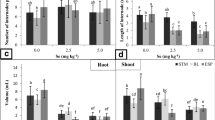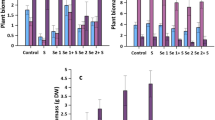Abstract
The present communication elucidates initially the topographic distribution of selenium in barley grains. Then by the fluorimetric method the uptake of selenium (selenite) in 8–16 d old germinating barley was estimated. Finally by means of75Se the anabolic and catabolic rates (turnover) of75Se (selenite) was compared.
The distribution of selenium in barley was evaluated after microdissection of barley grains. In dried grains the highest concentration was found in husk and pericarp with about 0.6 ppm Se. Then followed Scutellum with 0.4 and 0.3 ppm in embryon. The aleurone layer, embryonic leaves, and initial root did only have 0.2 ppm Se. In order to know more about the uptake and distribution of selenium in 8-d-old barley, the plants were cultivated for a further 8 d in the culture medium with variation in selenite concentration. In roots and leaves, the uptake did not arrive at saturation during the period studied since the dose-response curve increased up to 0.34 mM selenite in the medium, whereas the selenium levels were about 200 ppm in roots and 30 ppm in leaves. However, the uptake was linear, with concentration during 8 d of cultivation up to 0.84 μM selenite for grain and stem. At higher concentrations the dose-response curve diminished its slope. At 0.34 mM selenite the concentration in grain increased to 6.87 ppm and in the stem to 8.13 ppm.
The uptake, distribution, and catabolic rate of selenium components in germinating barley were further evaluated by exposing the plants to 0.0492 μCi75Se (12.6 μM selenite) for up to 4 d. Then the plants were moved to a selenium deficient medium for further 4 d. Then finally the medium was supplemented with high doses of cold selenite (0.126 mM selenite) for further 4 d. The first third period made it possible to estimate the rate of uptake. It was highest in roots (313 fmol/h/mg dw), i.e., about 10 times those of grains, stems, and leaves. The intermediate period where the barley was transferred to a selenium deficient medium made it possible to estimate the kinetics and eventual sparing mechanisms. The selenium losses were highest for leaves (39%), then followed by roots and stems (22 and 25%, respectively). The losses were lowest in grain with 9% Se losses. The losses were three times more pronounced during the first day than in the following 3 d. These data may argue that the selenium is distributed into different pools and that sparing mechanisms may be in function. The last period, i.e., the chase experiment, revealed the rate of elimination of selenium under conditions with surplus selenium. The catabolic rate was about 10 times faster in roots (169 fmol/h/mg dw) than in grains and about 8 times faster than in leaves.
Similar content being viewed by others
References
T. Koljonen,Ambio 7, 169–171 (1978).
A. Schrift, Metabolism of selenium by plants and microorganisms, inOrganic Selenium Compounds, their Chemistry and Biology, D. L. Klayman and W. H. H. Gunther, eds., John Wiley, New York, pp. 763–814 (1973).
C. Wilcke, J. Urban, D. Hubner, K. Graeser, and S. Szymczyk, Spurenelemente Von Pilzen Im Vergleich Von PIXE-analyse Und AAS, inMengen und Spurenelemente, (1990).
P. Varo and M. Nuurtamo, Selenium in foods and diets, inA Nordic Symposium on Soil-Plant-Animal-Man Interrelationships and Implications to Human Health: Mineral Elements 1980, Hanasaari Culture Center, Helsinki-Espoo, Finland, pp. 545, 555 (1981).
G. Gissel-Nielsen,Proc. Symp. Otaniemi, August 1973, 333–339 (1974).
G. Gissel-Nielsen,Acta Agr. Scand. 25, 216–220 (1975).
G. Gissel-Nielsen, Selenium in soils and plants, inProc. Symp. Selenium-Tellurium in the Environment, May 1976, Univ. Notre Dame, Indiana, Industrial Health Foundation, Pittsburgh, PA, pp. 10–25 (1976).
J. Korkman,J. Sci. Agric Soc. Finl. 52(5), 495–504 (1980).
U. C. Gupta, K. B. Mcrae, and K. A. Winter,Can. J. Soil Sci. 68(3), 519–526 (1988).
P. Sima and G. Gissel-Nielsen,Acta Agric. Scand. 35(2), 161–164 (1985).
T. Ylaranta,Ann. Agric. Fenn. 23(2), 75–84 (1985).
R. L. Mikkelsen and H. F. Wan,Plant Soil 121(1), 151–153 (1990).
U. C. Gupta and K. A. Winter,Can. J. Soil Sci. 69(4), 885–888 (1989).
K. Lindstrøm, and W. Rodhe,Mitt. Intl. Verein. Limnol. 21, 168–173 (1978).
W. Rodhe,Mitt. Intl. Verein. Limnol. 21, 7–20 (1978).
E. Kjellquist and J. H. Jaeiseusu,The Nordic Barley Catalogul. Amarp., Nadic Gene Bank ISSN 11UO-3456., Almarp. p. 86 (1989).
O. E. Olson, Methods of analysis for selenium, inProc. Symp. Selenium-Tellurium in the Environment, May 1976, Univ. Notre Dame, Indiana, Industrial Health Foundation-Pittsburgh, PA, 67–84 (1976).
F. C. Steward,Plant physiology vol. III. Inorganic nutrition of plants, Academic Press, New York and London (1963).
H. G. Gauch,Inorganic Plant Nutrition, Dowden, Hutchinson and Ross, Stroudsburg (1972).
J. Clausen,Biol. Trace Elem. Res. 28(1), 57–68 (1991).
A. Shrift,Ann. Rev. Plant Physiol. 20, 475 (1969).
C. M. Johnson, C. J. Asher, and T. C. Broyer, Distribution of Se in plants, inSelenium in Biomedicine, O. H. Muth, ed., AVI Publishing, Westport, CT, 57 (1967).
G. W. Butler and P. J. Prterson,Aust. J. Biol. Sci. 20, 77 (1967).
G. Gissel-Nielsen, Selenium in soils and plants. In,Proc. Symp. Selenium-Tellurium in the Environment, May 1976, Univ. Notre Dame, Indiana, Industrial Health Foundation, Pittsburgh, PA, 10–25 (1976).
N. Terry, C. Carlson, T. K. Raab, and A. M. Zayed,J. Environ. Qual. 21(3) 341–344 (1992).
R. Zieveand and P. J. Peterson,Sci. Total Environ. 32(2),197–202 (1984).
Author information
Authors and Affiliations
Rights and permissions
About this article
Cite this article
Huang, K.X., Clausen, J. Uptake, distribution, and turnover rates of selenium in barley. Biol Trace Elem Res 40, 213–223 (1994). https://doi.org/10.1007/BF02950794
Received:
Revised:
Accepted:
Issue Date:
DOI: https://doi.org/10.1007/BF02950794




